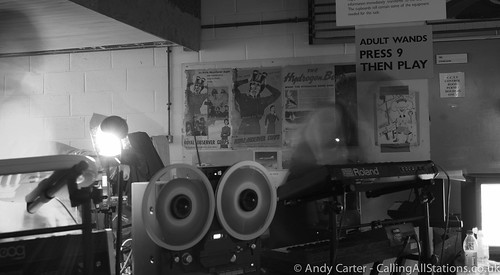W mass data. The peak corresponding to hemachatoxin was pooled and rechromatographed using a shallow gradient of 35?5 solvent B on the same column. The mass and homogeneity of purified hemachatoxin was analyzed as described above.RsymI/SigI Refinement ?Resolution range (A) I.s(I)b c30?.43 0.23 0.RworkRfreeRoot mean square deviation ?Bond lengths (A) Bond angles (u) ?Average B-factors (A2) Protein atoms (938 atoms) Water molecules (62 atoms) Wilson B value Ramachandran statistics Most favored regions ( ) Dimethylenastron site Allowed regions ( ) Disallowed regions ( ) 98.31 1.69 0 40.30 37.1 36.54 0.008 1.SequencingHemachatoxin (1.2 mg) was dissolved in 500 ml of denaturation buffer (130 mM Tris-HCl pH 8.5, 1 mM EDTA, 6 M guanidine HCl). After the addition of the reducing agent b-mercaptoethanol (1.23 ml; 256molar excess of disulfide bonds), the reaction mixture was incubated under a nitrogen stream for 3 h at room temperature. Subsequently, the alkylating reagent 4-vinylpyridine (5.7 ml; 36molar excess of b-mercaptoethanol) was added and incubated under a nitrogen stream for another 2 h at room temperature. The S-pyridylethylated protein was immediately separated from the reaction mixture by RP-HPLC on a Jupiter C18 column (4.66250 mm) using a linear gradient of 20?0 solvent B and the mass was determined by ESI-MS as discussed above. For cyanogen bromide (CNBr) cleavage, the S-pyridylethylated protein (0.82 mg) was dissolved in 410 ml of  70 TFA to which CNBr (67.7 ml in 70 TFA) was added in order to yield a final protein concentration of 1 mg/ml. 15900046 CNBr was used at a molar ratio to methionine residue of 200:1. The reaction tube was incubated in complete darkness for 24 h at room temperature. After 24 h, 8.2 ml of Milli-Q water (106 of reaction mixture) was added into the reaction tube and, subsequently, the reaction tube was lyophilized overnight [72]. The lyophilized sample was resolubilized in 3 ml of 0.1 TFA for separation by reverse-phase chromatography on a Jupiter C18 column (4.66250 mm) using a linear gradient of 10?0 solvent B. The masses of the peptide fragments were determined by ESI-MS (data not shown). The Nterminal sequence of order KS-176 native hemachatoxin and peptides generated by CNBr cleavage (identified by mass spectrometry data) were determined by automated Edman degradation using a PerkinElmer Life Sciences Model 494 pulsed liquid-phase sequencer (Procise, Foster City, USA) with an on-line Model 785A phenylthiohydantoin-derivative analyzer. The complete aminoStatistics from the current model. a Rsym = S|Ii2,I.|/S|Ii| where Ii is the intensity of the ith measurement, and ,I. is the mean intensity for that reflection. b Rwork = S| Fobs2Fcalc|/S|Fobs| where Fcalc and Fobs are the calculated and observed structure factor amplitudes, respectively. c Rfree = as for Rwork, but 1527786 for 10.0 of the total reflections chosen at random and omitted from refinement. *Values in the parenthesis are
70 TFA to which CNBr (67.7 ml in 70 TFA) was added in order to yield a final protein concentration of 1 mg/ml. 15900046 CNBr was used at a molar ratio to methionine residue of 200:1. The reaction tube was incubated in complete darkness for 24 h at room temperature. After 24 h, 8.2 ml of Milli-Q water (106 of reaction mixture) was added into the reaction tube and, subsequently, the reaction tube was lyophilized overnight [72]. The lyophilized sample was resolubilized in 3 ml of 0.1 TFA for separation by reverse-phase chromatography on a Jupiter C18 column (4.66250 mm) using a linear gradient of 10?0 solvent B. The masses of the peptide fragments were determined by ESI-MS (data not shown). The Nterminal sequence of order KS-176 native hemachatoxin and peptides generated by CNBr cleavage (identified by mass spectrometry data) were determined by automated Edman degradation using a PerkinElmer Life Sciences Model 494 pulsed liquid-phase sequencer (Procise, Foster City, USA) with an on-line Model 785A phenylthiohydantoin-derivative analyzer. The complete aminoStatistics from the current model. a Rsym = S|Ii2,I.|/S|Ii| where Ii is the intensity of the ith measurement, and ,I. is the mean intensity for that reflection. b Rwork = S| Fobs2Fcalc|/S|Fobs| where Fcalc and Fobs are the calculated and observed structure factor amplitudes, respectively. c Rfree = as for Rwork, but 1527786 for 10.0 of the total reflections chosen at random and omitted from refinement. *Values in the parenthesis are  the highest resolution bin values. doi:10.1371/journal.pone.0048112.tcardiotoxins [70,71]. We compared the B values of the cardiotoxin loops with those of hemachatoxin. All three loops in P-type ?cardiotoxins showed a high B value (an increase of 5? A2) compared with the rest of the molecule. A similar increase in B ?values (upto 8 A2 increase) was also observed in hemachatoxin loops. Only loop II has the crystal contact suggesting that the observed increase in B values might be limited by the symmetry contacts. Nonetheless this analysis suggests that loop II is flexibl.W mass data. The peak corresponding to hemachatoxin was pooled and rechromatographed using a shallow gradient of 35?5 solvent B on the same column. The mass and homogeneity of purified hemachatoxin was analyzed as described above.RsymI/SigI Refinement ?Resolution range (A) I.s(I)b c30?.43 0.23 0.RworkRfreeRoot mean square deviation ?Bond lengths (A) Bond angles (u) ?Average B-factors (A2) Protein atoms (938 atoms) Water molecules (62 atoms) Wilson B value Ramachandran statistics Most favored regions ( ) Allowed regions ( ) Disallowed regions ( ) 98.31 1.69 0 40.30 37.1 36.54 0.008 1.SequencingHemachatoxin (1.2 mg) was dissolved in 500 ml of denaturation buffer (130 mM Tris-HCl pH 8.5, 1 mM EDTA, 6 M guanidine HCl). After the addition of the reducing agent b-mercaptoethanol (1.23 ml; 256molar excess of disulfide bonds), the reaction mixture was incubated under a nitrogen stream for 3 h at room temperature. Subsequently, the alkylating reagent 4-vinylpyridine (5.7 ml; 36molar excess of b-mercaptoethanol) was added and incubated under a nitrogen stream for another 2 h at room temperature. The S-pyridylethylated protein was immediately separated from the reaction mixture by RP-HPLC on a Jupiter C18 column (4.66250 mm) using a linear gradient of 20?0 solvent B and the mass was determined by ESI-MS as discussed above. For cyanogen bromide (CNBr) cleavage, the S-pyridylethylated protein (0.82 mg) was dissolved in 410 ml of 70 TFA to which CNBr (67.7 ml in 70 TFA) was added in order to yield a final protein concentration of 1 mg/ml. 15900046 CNBr was used at a molar ratio to methionine residue of 200:1. The reaction tube was incubated in complete darkness for 24 h at room temperature. After 24 h, 8.2 ml of Milli-Q water (106 of reaction mixture) was added into the reaction tube and, subsequently, the reaction tube was lyophilized overnight [72]. The lyophilized sample was resolubilized in 3 ml of 0.1 TFA for separation by reverse-phase chromatography on a Jupiter C18 column (4.66250 mm) using a linear gradient of 10?0 solvent B. The masses of the peptide fragments were determined by ESI-MS (data not shown). The Nterminal sequence of native hemachatoxin and peptides generated by CNBr cleavage (identified by mass spectrometry data) were determined by automated Edman degradation using a PerkinElmer Life Sciences Model 494 pulsed liquid-phase sequencer (Procise, Foster City, USA) with an on-line Model 785A phenylthiohydantoin-derivative analyzer. The complete aminoStatistics from the current model. a Rsym = S|Ii2,I.|/S|Ii| where Ii is the intensity of the ith measurement, and ,I. is the mean intensity for that reflection. b Rwork = S| Fobs2Fcalc|/S|Fobs| where Fcalc and Fobs are the calculated and observed structure factor amplitudes, respectively. c Rfree = as for Rwork, but 1527786 for 10.0 of the total reflections chosen at random and omitted from refinement. *Values in the parenthesis are the highest resolution bin values. doi:10.1371/journal.pone.0048112.tcardiotoxins [70,71]. We compared the B values of the cardiotoxin loops with those of hemachatoxin. All three loops in P-type ?cardiotoxins showed a high B value (an increase of 5? A2) compared with the rest of the molecule. A similar increase in B ?values (upto 8 A2 increase) was also observed in hemachatoxin loops. Only loop II has the crystal contact suggesting that the observed increase in B values might be limited by the symmetry contacts. Nonetheless this analysis suggests that loop II is flexibl.
the highest resolution bin values. doi:10.1371/journal.pone.0048112.tcardiotoxins [70,71]. We compared the B values of the cardiotoxin loops with those of hemachatoxin. All three loops in P-type ?cardiotoxins showed a high B value (an increase of 5? A2) compared with the rest of the molecule. A similar increase in B ?values (upto 8 A2 increase) was also observed in hemachatoxin loops. Only loop II has the crystal contact suggesting that the observed increase in B values might be limited by the symmetry contacts. Nonetheless this analysis suggests that loop II is flexibl.W mass data. The peak corresponding to hemachatoxin was pooled and rechromatographed using a shallow gradient of 35?5 solvent B on the same column. The mass and homogeneity of purified hemachatoxin was analyzed as described above.RsymI/SigI Refinement ?Resolution range (A) I.s(I)b c30?.43 0.23 0.RworkRfreeRoot mean square deviation ?Bond lengths (A) Bond angles (u) ?Average B-factors (A2) Protein atoms (938 atoms) Water molecules (62 atoms) Wilson B value Ramachandran statistics Most favored regions ( ) Allowed regions ( ) Disallowed regions ( ) 98.31 1.69 0 40.30 37.1 36.54 0.008 1.SequencingHemachatoxin (1.2 mg) was dissolved in 500 ml of denaturation buffer (130 mM Tris-HCl pH 8.5, 1 mM EDTA, 6 M guanidine HCl). After the addition of the reducing agent b-mercaptoethanol (1.23 ml; 256molar excess of disulfide bonds), the reaction mixture was incubated under a nitrogen stream for 3 h at room temperature. Subsequently, the alkylating reagent 4-vinylpyridine (5.7 ml; 36molar excess of b-mercaptoethanol) was added and incubated under a nitrogen stream for another 2 h at room temperature. The S-pyridylethylated protein was immediately separated from the reaction mixture by RP-HPLC on a Jupiter C18 column (4.66250 mm) using a linear gradient of 20?0 solvent B and the mass was determined by ESI-MS as discussed above. For cyanogen bromide (CNBr) cleavage, the S-pyridylethylated protein (0.82 mg) was dissolved in 410 ml of 70 TFA to which CNBr (67.7 ml in 70 TFA) was added in order to yield a final protein concentration of 1 mg/ml. 15900046 CNBr was used at a molar ratio to methionine residue of 200:1. The reaction tube was incubated in complete darkness for 24 h at room temperature. After 24 h, 8.2 ml of Milli-Q water (106 of reaction mixture) was added into the reaction tube and, subsequently, the reaction tube was lyophilized overnight [72]. The lyophilized sample was resolubilized in 3 ml of 0.1 TFA for separation by reverse-phase chromatography on a Jupiter C18 column (4.66250 mm) using a linear gradient of 10?0 solvent B. The masses of the peptide fragments were determined by ESI-MS (data not shown). The Nterminal sequence of native hemachatoxin and peptides generated by CNBr cleavage (identified by mass spectrometry data) were determined by automated Edman degradation using a PerkinElmer Life Sciences Model 494 pulsed liquid-phase sequencer (Procise, Foster City, USA) with an on-line Model 785A phenylthiohydantoin-derivative analyzer. The complete aminoStatistics from the current model. a Rsym = S|Ii2,I.|/S|Ii| where Ii is the intensity of the ith measurement, and ,I. is the mean intensity for that reflection. b Rwork = S| Fobs2Fcalc|/S|Fobs| where Fcalc and Fobs are the calculated and observed structure factor amplitudes, respectively. c Rfree = as for Rwork, but 1527786 for 10.0 of the total reflections chosen at random and omitted from refinement. *Values in the parenthesis are the highest resolution bin values. doi:10.1371/journal.pone.0048112.tcardiotoxins [70,71]. We compared the B values of the cardiotoxin loops with those of hemachatoxin. All three loops in P-type ?cardiotoxins showed a high B value (an increase of 5? A2) compared with the rest of the molecule. A similar increase in B ?values (upto 8 A2 increase) was also observed in hemachatoxin loops. Only loop II has the crystal contact suggesting that the observed increase in B values might be limited by the symmetry contacts. Nonetheless this analysis suggests that loop II is flexibl.
